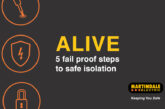
Gary Parker, Senior Technical Manager at ECA and Paul Collins, Head of Technical Services at NICEIC, discuss changes to the Electrotechnical Assessment Specification and what this will mean for electrical businesses, and the wider industry, moving forwards.
The Electrotechnical Assessment Specification (EAS) sets out the minimum requirements for a business to be recognised as technically competent by a Certification or Registration Body (such as the NICEIC). The latest version of the EAS came into effect in October 2021, and the changes within it affect all businesses registered with a certification or registration body.
So, what’s changed?
As the electrical industry evolves, the criteria for competence evolve as well. EAS no longer accepts short courses, auditable evidence, or certificates of competence as forms of recognised training and education. This change effectively closes ‘short course’ entry routes for new Qualified Supervisor applicants.
Electrical work is skilled, and must be undertaken by qualified, competent businesses. The EAS document underpins how we as an industry assess this, and the update reflects our continued focus on improvement.
ECA, NICEIC and other Certification and Registration Bodies are committed to implementing change to drive improvement across the industry.
What do installers need to do?
Documentation: Businesses now need to keep all documents required for the assessment for a minimum period of six years. This includes specifications, certificates, reports, complaints, health and safety information, on-going accuracy of test instruments and so on.
Organisations also need to have access to GS 38 (a HSE guidance note related to electrical test equipment), as well as access to the current Edition of BS 7671 (the Requirements for Electrical Installations). Paper or electronic versions of these documents are acceptable for assessment purposes.
Supervision: One of the most important changes is the new requirement associated with competence and adequate supervision of all employed persons undertaking electrotechnical work. That means full and part-time staff, as well as subcontractors. ECA has developed a free tool for members called eCOMS to assist with logging CPD, training records and supervision.
Insurance: In addition to having £2 million public liability insurance, businesses that undertake periodic inspection and issue EICRs must have at least £250,000 professional indemnity insurance.
Safe isolation: Another key change is the need to demonstrate the ability to undertake safe isolation practices. Most people are taught about safe isolation in the first year of their apprenticeship or training. We all know about it, yet it often gets forgotten. About seven people per year die from simply not undertaking safe isolation. That’s seven too many.
CPD: Businesses also need to maintain appropriate records of qualifications, training (including Continuing Professional Development) and experience. This could be demonstrated through personnel records, training matrices, contractor records and assessment procedures or other documented records as appropriate for the Enterprise.
Qualifications of key personnel
Key personnel typically include the Principal Duty Holder (PDH) and Qualified Supervisor (QS). Businesses should have a sufficient number of QSs for the work being carried out, although they’re not required to be on-site at all times.
QSs are responsible for the quality and safety of the work being performed, and should a QS change, the PDH has 30 days to inform the certification body. A new QS must be in place within 120 days.
Existing QSs are required to hold an 18th Edition Wiring Regulation qualification; they can no longer simply demonstrate an understanding of it. We strongly suggest upskilling for those looking to expand their knowledge, and diversifying into areas such as solar panels, heat pumps, electric vehicles or other green technologies.
For those new to the position of QS, the qualification requirements have changed. To meet these new requirements, new QSs (and QS applicants) will be required to hold the 18th Edition Wiring Regulations and relevant inspection and testing qualifications as well as other qualifications available through apprenticeships or experienced worker assessment routes and CPD.
The assessment experience
Now the new EAS is in place, assessments will no longer be the same. As there are additional things for assessors to check, we recommend compiling a checklist.
Contractors should make sure as many elements as possible have been covered before the assessment. Competence will be one of the key things the assessor will review, so it’s vital to have suitable documentation in place, for example training and CPD records.
We appreciate these changes may require some adjustment, but it is important to remember that, in safety-critical professions like ours, continually raising standards is crucial. Embrace the change and use this opportunity to focus on updating your knowledge and skills and improving your business.
To visit the ECA website click here
To visit the NICEIC website click here









